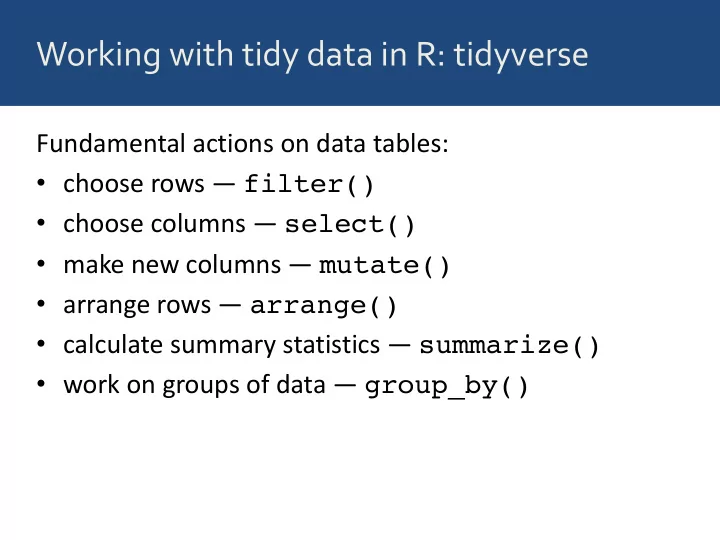

Working with tidy data in R: tidyverse Fundamental actions on data tables: • choose rows — filter() • choose columns — select() • make new columns — mutate() • arrange rows — arrange() • calculate summary statistics — summarize() • work on groups of data — group_by()
We can combine these verbs using the pipe operator: %>% Standard R: > mean(iris$Sepal.Length) [1] 5.843333 With pipe: > iris$Sepal.Length %>% mean() [1] 5.843333
We can combine these verbs using the pipe operator: %>% Standard R: > head(iris) Sepal.Length Sepal.Width Petal.Length Petal.Width Species 1 5.1 3.5 1.4 0.2 setosa 2 4.9 3.0 1.4 0.2 setosa 3 4.7 3.2 1.3 0.2 setosa 4 4.6 3.1 1.5 0.2 setosa 5 5.0 3.6 1.4 0.2 setosa 6 5.4 3.9 1.7 0.4 setosa
We can combine these verbs using the pipe operator: %>% With pipe: > iris %>% head() Sepal.Length Sepal.Width Petal.Length Petal.Width Species 1 5.1 3.5 1.4 0.2 setosa 2 4.9 3.0 1.4 0.2 setosa 3 4.7 3.2 1.3 0.2 setosa 4 4.6 3.1 1.5 0.2 setosa 5 5.0 3.6 1.4 0.2 setosa 6 5.4 3.9 1.7 0.4 setosa
Combining pipe and assignment These two lines do the same thing: > mean_length <- mean(iris$Sepal.Length) > mean_length <- iris$Sepal.Length %>% mean() > mean_length [1] 5.843333
Pipe example 1: count how many herbivores of different orders there are in msleep
Pipe example 1: count how many herbivores of different orders there are in msleep msleep %>% filter(vore == "herbi")
Pipe example 1: count how many herbivores of different orders there are in msleep msleep %>% filter(vore == "herbi") %>% group_by(order)
Pipe example 1: count how many herbivores of different orders there are in msleep msleep %>% filter(vore == "herbi") %>% group_by(order) %>% summarize(count = n())
Pipe example 1: count how many herbivores of different orders there are in msleep msleep %>% filter(vore == "herbi") %>% group_by(order) %>% summarize(count = n()) %>% arrange(desc(count))
Pipe example 1: count how many herbivores of different orders there are in msleep msleep %>% filter(vore == "herbi") %>% group_by(order) %>% summarize(count = n()) %>% arrange(desc(count)) order count 1 Rodentia 16 2 Artiodactyla 5 3 Perissodactyla 3 4 Hyracoidea 2 5 Proboscidea 2 6 Diprotodontia 1 7 Lagomorpha 1 8 Pilosa 1 9 Primates 1
Pipe example 2: What is total day time for each animal in msleep ?
Pipe example 2: What is total day time for each animal in msleep ? msleep %>% mutate(total_day_time = awake + sleep_total)
Pipe example 2: What is total day time for each animal in msleep ? msleep %>% mutate(total_day_time = awake + sleep_total) %>% select(name, total_day_time)
Pipe example 2: What is total day time for each animal in msleep ? msleep %>% mutate(total_day_time = awake + sleep_total) %>% select(name, total_day_time) name total_day_time 1 Cheetah 24.00 2 Owl monkey 24.00 3 Mountain beaver 24.00 4 Greater short-tailed shrew 24.00 5 Cow 24.00 6 Three-toed sloth 24.00 7 Northern fur seal 24.00 8 Vesper mouse 24.00 9 Dog 24.00 10 Roe deer 24.00
Pipe example 3: What is the median awake time of different orders in msleep ?
Pipe example 3: What is the median awake time of different orders in msleep ? msleep %>% group_by(order)
Pipe example 3: What is the median awake time of different orders in msleep ? msleep %>% group_by(order) %>% summarize(med_awake = median(awake))
Pipe example 3: What is the median awake time of different orders in msleep ? msleep %>% group_by(order) %>% summarize(med_awake = median(awake)) %>% arrange(med_awake)
Pipe example 3: What is the median awake time of different orders in msleep ? msleep %>% group_by(order) %>% summarize(med_awake = median(awake)) %>% arrange(med_awake) order med_awake 1 Chiroptera 4.20 2 Didelphimorphia 5.30 3 Cingulata 6.25 4 Afrosoricida 8.40 5 Pilosa 9.60 6 Rodentia 11.10 7 Diprotodontia 11.60 8 Soricomorpha 13.70 9 Carnivora 13.75 10 Erinaceomorpha 13.80
Recommend
More recommend